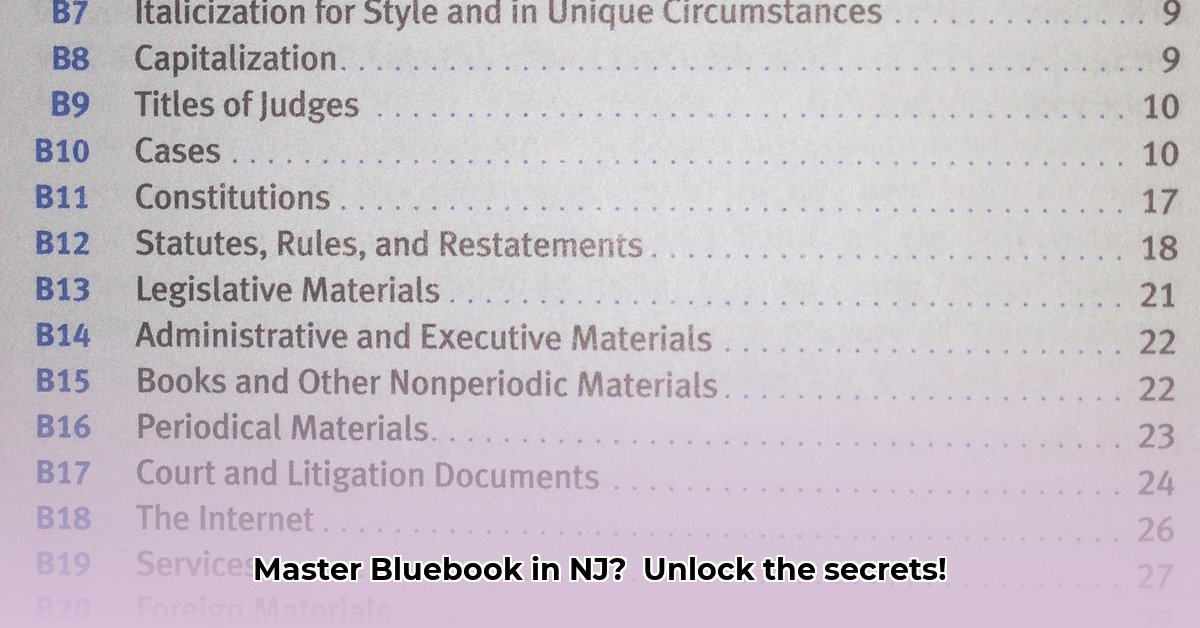
Bluebook D.N.J.: Your Plain-English Guide to New Jersey Legal Citations
Legal citations can be confusing. This guide simplifies Bluebook D.N.J. citation—the style for citing New Jersey cases—ensuring your legal writing is clear, professional, and error-free.
Getting Started with Bluebook D.N.J.
The Bluebook provides a uniform system for legal citation in the U.S. Bluebook D.N.J. specifically addresses New Jersey court cases, ensuring clarity and consistency in legal communication. Accurate citations are crucial for establishing credibility and avoiding ambiguity.
Key elements of a Bluebook D.N.J. citation include:
- Case Name: The names of the parties involved (e.g., State v. Smith).
- Reporter: The volume and page number in the official report where the case is published.
- Court: The court that decided the case (Supreme Court? Appellate Division? Superior Court?).
- Year: The year of the decision.
A basic example: State v. Smith, 123 N.J. 456 (2000). "N.J." refers to the New Jersey Reports, where New Jersey Supreme Court decisions are published.
Understanding New Jersey's Court System
New Jersey's court structure mirrors the federal system's tiered approach:
- New Jersey Supreme Court: The highest court of appeal.
- Appellate Division: Reviews decisions from lower courts.
- Superior Court: The trial court, with various specialized divisions (Law Division, Chancery Division, etc.).
The court of origin significantly impacts citation format.
Key Differences: Superior Court vs. Appellate Division Citations
The citation style varies depending on the originating court:
| Court Type | Bluebook D.N.J. Abbreviation | Example |
|---|---|---|
| New Jersey Supreme Court | N.J. | State v. Jones, 123 N.J. 456 (2000) |
| Appellate Division | N.J. Super. | Doe v. Roe, 123 N.J. Super. 456 (App. Div. 2000) |
| Superior Court, Law Div. | N.J. Super. | Smith v. Brown, 123 N.J. Super. 456 (Law Div. 2000) |
Note the additions of "App. Div." or "Law Div." for clarity. Omitting these is a common error.
Your Step-by-Step Guide to Perfect Bluebook D.N.J. Citations
To cite a case effectively:
- Gather Information: Note the case name, court, year, and reporter information.
- Select the Correct Abbreviation: Use the table above to identify the appropriate court abbreviation.
- Assemble the Citation: Follow the Bluebook's prescribed format precisely.
- Verify Accuracy: Always proofread your citations carefully.
Handling Unreported Cases and Other Sources
The Bluebook provides specific guidance for citing unreported cases and decisions from courts like the New Jersey Tax Court. Consult the full Bluebook for detailed instructions.
How to Navigate Jurisdictional Nuances in the US Federal Court System
Mastering Bluebook D.N.J. is part of understanding the broader US federal court system.
Demystifying the Federal Court Hierarchy
The federal court system has a hierarchical structure:
- District Courts: Trial courts of original jurisdiction.
- Courts of Appeals (Circuit Courts): Hear appeals from District Courts.
- Supreme Court: The highest court of appeal, with discretionary jurisdiction.
Understanding this hierarchy is crucial for determining which court has jurisdiction over a specific case.
Jurisdictional Boundaries: Where Do Cases Belong?
Federal courts hear cases involving federal law, while state courts address state laws. Concurrent jurisdiction sometimes exists. Correctly identifying a case's jurisdictional home is essential for efficient legal practice.
The Importance of Precise Bluebook D.N.J. Citation
Accurate citation is paramount in legal writing. Bluebook D.N.J. provides a standardized method to cite New Jersey federal court cases, ensuring clarity and professionalism.
Practical Steps for Navigating Jurisdictional Issues
- Identify Case Type: Determine whether the case involves a federal question or diversity jurisdiction.
- Determine the Relevant Court: Consult jurisdictional statutes and rules to confirm the proper court.
- Research Precedents: Review relevant case law for guidance on court selection.
- Cite Correctly: Employ the Bluebook's D.N.J. style for precise and consistent citation.
- Thorough Review: Before filing, carefully review all documentation for accuracy.
Mastering the Nuances: A Continuous Process
Keeping up-to-date on legal developments, including changes in rules, case law, and Bluebook updates, is crucial for effective navigation of jurisdictional issues within the US federal court system.
⭐⭐⭐⭐☆ (4.8)
Download via Link 1
Download via Link 2
Last updated: Sunday, April 27, 2025